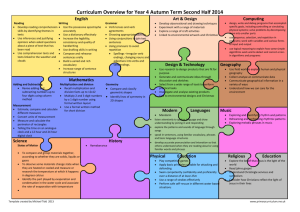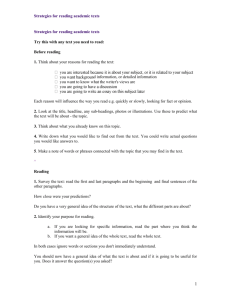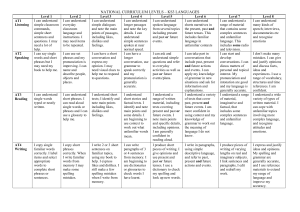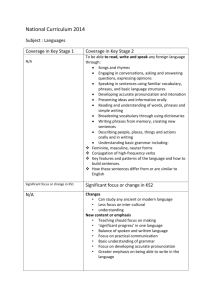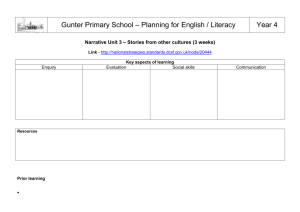Year 1 Narrative Unit 2 – Stories from a range of cultures
advertisement
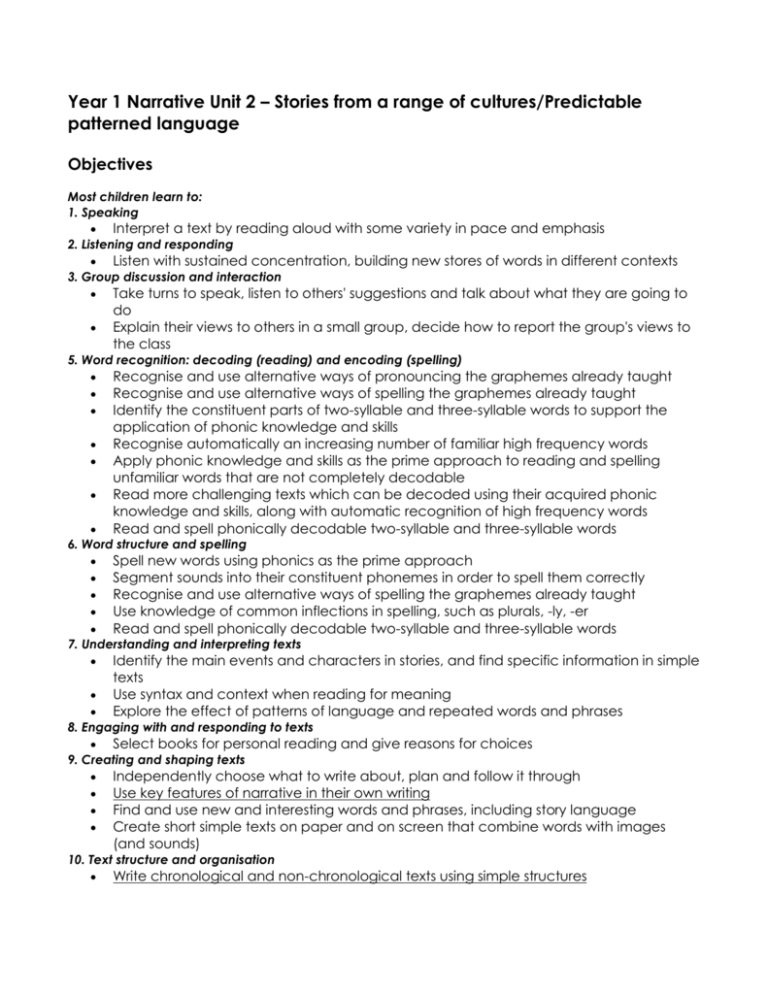
Year 1 Narrative Unit 2 – Stories from a range of cultures/Predictable patterned language Objectives Most children learn to: 1. Speaking Interpret a text by reading aloud with some variety in pace and emphasis 2. Listening and responding Listen with sustained concentration, building new stores of words in different contexts 3. Group discussion and interaction Take turns to speak, listen to others' suggestions and talk about what they are going to do Explain their views to others in a small group, decide how to report the group's views to the class 5. Word recognition: decoding (reading) and encoding (spelling) Recognise and use alternative ways of pronouncing the graphemes already taught Recognise and use alternative ways of spelling the graphemes already taught Identify the constituent parts of two-syllable and three-syllable words to support the application of phonic knowledge and skills Recognise automatically an increasing number of familiar high frequency words Apply phonic knowledge and skills as the prime approach to reading and spelling unfamiliar words that are not completely decodable Read more challenging texts which can be decoded using their acquired phonic knowledge and skills, along with automatic recognition of high frequency words Read and spell phonically decodable two-syllable and three-syllable words 6. Word structure and spelling Spell new words using phonics as the prime approach Segment sounds into their constituent phonemes in order to spell them correctly Recognise and use alternative ways of spelling the graphemes already taught Use knowledge of common inflections in spelling, such as plurals, -ly, -er Read and spell phonically decodable two-syllable and three-syllable words 7. Understanding and interpreting texts Identify the main events and characters in stories, and find specific information in simple texts Use syntax and context when reading for meaning Explore the effect of patterns of language and repeated words and phrases 8. Engaging with and responding to texts Select books for personal reading and give reasons for choices 9. Creating and shaping texts Independently choose what to write about, plan and follow it through Use key features of narrative in their own writing Find and use new and interesting words and phrases, including story language Create short simple texts on paper and on screen that combine words with images (and sounds) 10. Text structure and organisation Write chronological and non-chronological texts using simple structures 11. Sentence structure and punctuation Compose and write simple sentences independently to communicate meaning Use capital letters and full stops when punctuating simple sentences 12. Presentation Write most letters, correctly formed and orientated, using a comfortable and efficient pencil grip Write with spaces between words accurately Complete teaching sequence Note: This sequence is designed to be repeated twice during the unit. Note: Children working significantly above or below age-related expectations will need differentiated support, which may include tracking forward or back in terms of learning objectives. EAL learners should be expected to work within the overall expectations for their year group. For further advice see the progression strands and hyperlinks to useful sources of practical support. Phase 1: Reading; analysis; response (3 days) Teaching content: Read a selection of stories with predictable and patterned language. Include examples from or about different cultures. Read each story aloud more than once and discuss what makes a particular story distinctive. Look for patterns, for example repetition, rhythm, rhyme. Demonstrate how to use these features to support reading: for example, identify a pattern where the final word rhymes in each pair of lines and use this to check for accuracy and meaning as you read. Involve children in trying this themselves. Talk about the effect of patterns of language and repeated words and phrases, for example changing the pace of the story, making it memorable, giving a character a catch phrase, signalling the next part of the story. Encourage children to express their response, for example which words, phrases or patterns they liked and why. Once children are familiar with a story, encourage them to join in and then recite parts of the text. Learning outcome: Children can recognise language patterns and repeated words and phrases in a text and discuss their effect on a reader. Phase 2: Language play; writing (2 days) Teaching content: Use language play to explore, extend and adapt patterns from the text, for example substituting words and phrases in lines from the text, extending rhyming or alliterative patterns, inventing patterns, playing with rhyme and adding further rhyming words. Encourage children to join in and then to make up their own examples. Select some ideas from the language play and demonstrate how to write new lines or a new part of a particular story. Say the whole sentence aloud before writing and keep rereading to check that it sounds right and that you have chosen the best words. Reinforce the application of spelling strategies and correct sentence punctuation. Children write their own lines or sentences using a pattern from the story and ideas from language play. Encourage them to rehearse orally before they write and to keep rereading, checking and improving as they go along. Learning outcome: Children can write their own sentences based on patterned language from a familiar text. Phase 3: Rereading; group discussion (2 days) Teaching content: Reread a patterned text which is from or about another culture. Involve children in identifying the characters, setting and main events. Talk about what is familiar and unfamiliar, for example settings and characters from another country. Involve children in finding evidence in the story and pictures to give specific information. Discuss and agree as a class the distinctive features of the book and things that children like, such as patterns of rhyme or rhythm, particular words or phrases. Give groups of children further books to read and discuss. Select books at an appropriate level, for example books already read in guided reading. Groups discuss their book and then report back to the class, for example what was familiar or unfamiliar, any patterns they spotted, favourite words or phrases. Learning outcome: Children can work as part of a group, taking turns sharing ideas, listening to others and reporting their findings. Phase 4: Storytelling; writing (3 days) Teaching content: Select a familiar patterned story to use as a model for telling and writing a new story. Show children a story outline presented as notes for the beginning, middle and end of the story and begin telling an oral version. Ask children to think about ways to develop and complete the story and use drama to explore alternative ideas. Talk about the similarities to and differences from the original story and the ways that you have used or changed the patterns in the written text. Demonstrate how to plan and begin a written version of the story. Include examples of patterned language or repetitions in the style of the original story. Rehearse sentences orally and reread as you are writing. Ask children to plan and write their own ideas for the middle of the story independently, for example repeated refrain or a catch phrase for a particular character. Expect them to use words and phrases from the stories you have read, to write in complete sentences and to keep rereading their writing. Incorporate ideas from children's writing for the middle of the story and demonstrate how to write the ending. Put together a class book to read or recite together. Learning outcome: Children can write simple sentences using patterned language, words and phrases taken from familiar stories. Key aspects of learning Empathy Children will learn about other worlds and consider the thoughts, feelings and actions of characters. Creative thinking Children will use their imaginations as they create new ways of using and extending familiar patterns for new stories. Social skills Children will learn about taking turns, listening to others and trying to reach agreement as they work together in a group. Communication Children will develop their ability to discuss as they work collaboratively in paired, group and whole-class contexts. They will communicate outcomes orally, in writing and through ICT if appropriate.

